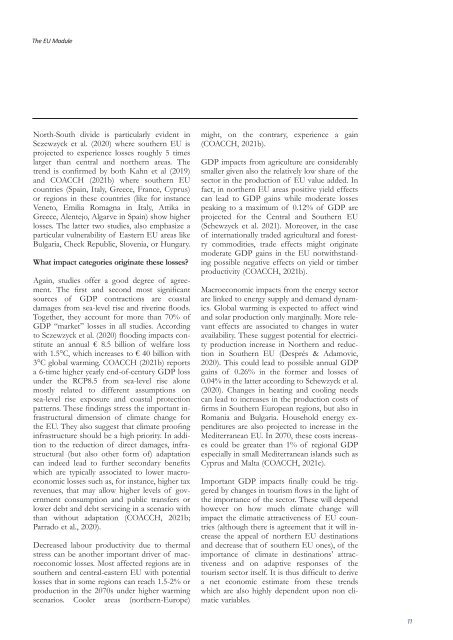EAERE Magazine - N.16 Spring 2022__
You also want an ePaper? Increase the reach of your titles
YUMPU automatically turns print PDFs into web optimized ePapers that Google loves.
The EU Module<br />
North-South divide is particularly evident in<br />
Sczewzyck et al. (2020) where southern EU is<br />
projected to experience losses roughly 5 times<br />
larger than central and northern areas. The<br />
trend is confirmed by both Kahn et al (2019)<br />
and COACCH (2021b) where southern EU<br />
countries (Spain, Italy, Greece, France, Cyprus)<br />
or regions in these countries (like for instance<br />
Veneto, Emilia Romagna in Italy, Attika in<br />
Greece, Alentejo, Algarve in Spain) show higher<br />
losses. The latter two studies, also emphasize a<br />
particular vulnerability of Eastern EU areas like<br />
Bulgaria, Check Republic, Slovenia, or Hungary.<br />
What impact categories originate these losses?<br />
Again, studies offer a good degree of agreement.<br />
The first and second most significant<br />
sources of GDP contractions are coastal<br />
damages from sea-level rise and riverine floods.<br />
Together, they account for more than 70% of<br />
GDP “market” losses in all studies. According<br />
to Sczewzyck et al. (2020) flooding impacts constitute<br />
an annual € 8.5 billion of welfare loss<br />
with 1.5°C, which increases to € 40 billion with<br />
3°C global warming. COACCH (2021b) reports<br />
a 6-time higher yearly end-of-century GDP loss<br />
under the RCP8.5 from sea-level rise alone<br />
mostly related to different assumptions on<br />
sea-level rise exposure and coastal protection<br />
patterns. These findings stress the important infrastructural<br />
dimension of climate change for<br />
the EU. They also suggest that climate proofing<br />
infrastructure should be a high priority. In addition<br />
to the reduction of direct damages, infrastructural<br />
(but also other form of) adaptation<br />
can indeed lead to further secondary benefits<br />
which are typically associated to lower macroeconomic<br />
losses such as, for instance, higher tax<br />
revenues, that may allow higher levels of government<br />
consumption and public transfers or<br />
lower debt and debt servicing in a scenario with<br />
than without adaptation (COACCH, 2021b;<br />
Parrado et al., 2020).<br />
Decreased labour productivity due to thermal<br />
stress can be another important driver of macroeconomic<br />
losses. Most affected regions are in<br />
southern and central-eastern EU with potential<br />
losses that in some regions can reach 1.5-2% or<br />
production in the 2070s under higher warming<br />
scenarios. Cooler areas (northern-Europe)<br />
might, on the contrary, experience a gain<br />
(COACCH, 2021b).<br />
GDP impacts from agriculture are considerably<br />
smaller given also the relatively low share of the<br />
sector in the production of EU value added. In<br />
fact, in northern EU areas positive yield effects<br />
can lead to GDP gains while moderate losses<br />
peaking to a maximum of 0.12% of GDP are<br />
projected for the Central and Southern EU<br />
(Schewzyck et al. 2021). Moreover, in the case<br />
of internationally traded agricultural and forestry<br />
commodities, trade effects might originate<br />
moderate GDP gains in the EU notwithstanding<br />
possible negative effects on yield or timber<br />
productivity (COACCH, 2021b).<br />
Macroeconomic impacts from the energy sector<br />
are linked to energy supply and demand dynamics.<br />
Global warming is expected to affect wind<br />
and solar production only marginally. More relevant<br />
effects are associated to changes in water<br />
availability. These suggest potential for electricity<br />
production increase in Northern and reduction<br />
in Southern EU (Després & Adamovic,<br />
2020). This could lead to possible annual GDP<br />
gains of 0.26% in the former and losses of<br />
0.04% in the latter according to Schewzyck et al.<br />
(2020). Changes in heating and cooling needs<br />
can lead to increases in the production costs of<br />
firms in Southern European regions, but also in<br />
Romania and Bulgaria. Household energy expenditures<br />
are also projected to increase in the<br />
Mediterranean EU. In 2070, these costs increases<br />
could be greater than 1% of regional GDP<br />
especially in small Mediterranean islands such as<br />
Cyprus and Malta (COACCH, 2021c).<br />
Important GDP impacts finally could be triggered<br />
by changes in tourism flows in the light of<br />
the importance of the sector. These will depend<br />
however on how much climate change will<br />
impact the climatic attractiveness of EU countries<br />
(although there is agreement that it will increase<br />
the appeal of northern EU destinations<br />
and decrease that of southern EU ones), of the<br />
importance of climate in destinations’ attractiveness<br />
and on adaptive responses of the<br />
tourism sector itself. It is thus difficult to derive<br />
a net economic estimate from these trends<br />
which are also highly dependent upon non climatic<br />
variables.<br />
11













